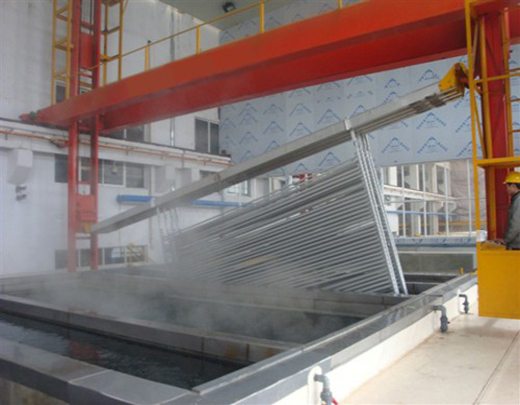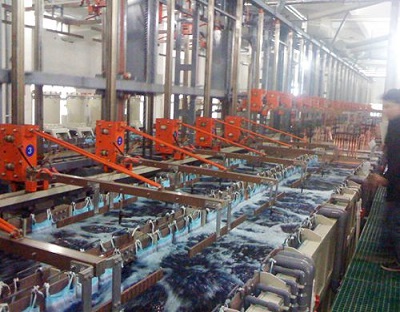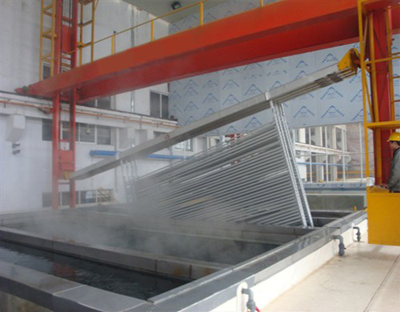Aluminum anodizing is generally carried out in acidic electrolyte, with aluminum as anode. In the process of electrolysis, the anion of oxygen reacts with aluminum to produce oxide film. The film is not fine enough at the beginning of formation. Although there is a certain resistance, the negative oxygen ions in the electrolyte can still reach the aluminum surface and continue to form an oxide film. With the increase of film thickness, the resistance increases and the electrolytic current decreases. At this time, the outer oxide film in contact with the electrolyte is chemically dissolved.
When the rate of oxide formation on the aluminum surface is gradually balanced with the rate of chemical dissolution, the oxide film can reach the thickness under this electrolytic parameter. The outer layer of aluminum anodized film is porous and easy to absorb dyes and colored substances, so it can be dyed and improve its decoration. After hot water, high temperature steam or nickel salt sealing treatment, the corrosion resistance and wear resistance of the oxide film can be further improved.
The coloring of aluminum materials shall be uniform and stable, and the color difference shall be controlled within a certain range to reduce the occurrence of coloring defects. In the actual production process, first strengthen the control of anodizing process operation, and pay attention to the following requirements during operation.
1. When the anodized profile enters the coloring tank, it must maintain a large inclination and be placed in the middle of the two poles to ensure the equal distance between the left and right poles. At the same time, the feeding and binding area shall be controlled, and the total surface area of each hanging material shall not exceed 44 ㎡.
2. Check whether the tank liquid concentration meets the process requirements.
3. During power transmission and coloring, the traveling crane hook and the conductive beam hook must be separated and allowed to stand for 0.5 ~ 1 minute before power transmission and coloring.
4. The coloring voltage of the same color must be equal, and the power supply voltage shall be adjusted in advance before coloring.
5. At the end of coloring, it shall be lifted immediately, the tank liquid shall be drained as soon as possible, and transferred to the water tank for washing as soon as possible. It is not allowed to stay in the coloring tank. The air lifting time shall be strictly controlled, and the color can be compared with the color plate only after the acid liquid in the inner hole of the profile is fully cleaned. During color comparison, the color of the profile shall be slightly deeper than that of the sample plate. When the color is too light, put it back into the coloring tank to power on and make up the color. When the color is too dark, put it back into the coloring tank (without power) or the acid water tank behind the oxidation tank to fade.
6. As the golden yellow cannot fade, the coloring time should not be set too long.
7. The colored profile shall be fully washed with secondary water before electrophoresis or hole sealing treatment.
8. Strengthen the washing before dyeing. After the workpiece is taken out of the anodizing tank, it shall be fully washed, especially the slit and blind hole of the workpiece, otherwise the residual acid and alkali will flow out slowly during the dyeing process, so that the pH value of the dyeing solution deviates from the normal range, and the color of the surface of the residual acid-base part is significantly different from that of the clean part, or even corrodes the oxide film and displays white.
9. Dye immediately after anodizing, and dye the workpiece immediately after anodizing. If the workpiece is exposed to air for too long after anodizing, the pores of the film will shrink and may be stained with dirt, resulting in difficult dyeing. If batch dyeing is required because the dyeing tank is too small, the parts to be dyed shall be soaked in clean water.
10. During dyeing, the workpieces shall not be overlapped. During dyeing, the workpieces shall not be overlapped, especially the plane parts, otherwise the overlapped parts will be covered to form the internal and external surfaces.
11. Strengthen the washing after dyeing. If the workpiece surface is not washed clean, residual pigment will pollute the assembly.








 Jul. 17, 2020
Jul. 17, 2020 



